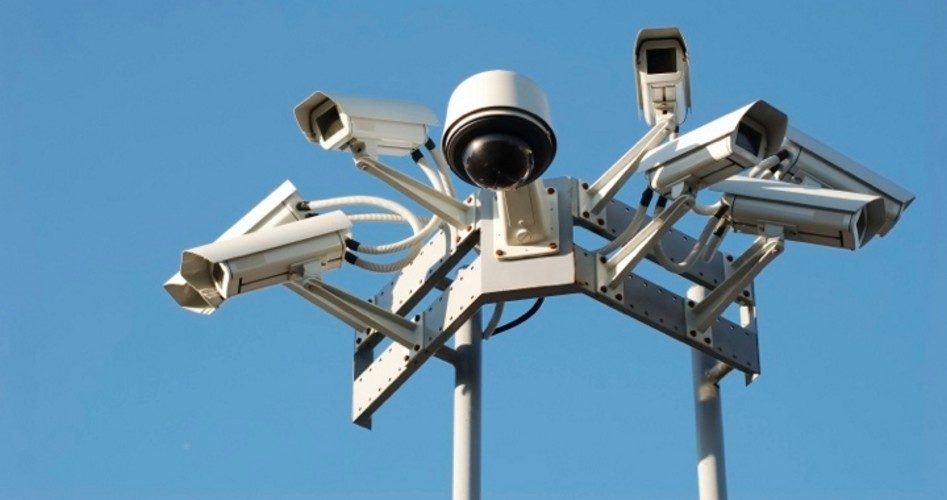
As the size and sponsorship of the global surveillance network TrapWire continues to be revealed, the “hacktivist” group Anonymous is calling on those alarmed by the multinational monitoring apparatus to unite August 18 in concerted opposition. “As we learn about TrapWire and similar systems in the surveillance industry, it becomes more apparent that we must, at all costs, shut this system down and render it useless,” spokesmen for Anonymous wrote in a press release.
Despite the purported power of the surveillance system, Anonymous recommends opponents protest peacefully. “An omniscient AI [Artificial Intelligence] electronic brain able to monitor us through the thick web of CCTV cameras, as well as online social media feeds is monstrous and Orwellian in its implications and possibilities. Anonymous will now put forth a call to arms. We will see to it that this evil and invasive system ceases to function, and the right to privacy is upheld,” the statement continues.
As we reported earlier this week, TrapWire is a massive and technologically advanced surveillance system that has the capacity to keep nearly the entire population of this country under the watchful eye of government 24 hours a day. Using this network of cameras and other surveillance tools, the federal government is rapidly constructing an impenetrable, inescapable theater of surveillance, most of which is going unnoticed by Americans and unreported by the mainstream media.
Unlike other elements of the central government’s cybersurveillance program, word about TrapWire was not leaked by Obama administration insiders. The details of this nearly unbelievable surveillance scheme were made public by WikiLeaks, the anti-secrecy group founded by Julian Assange.
The TrapWire story percolated from the millions of e-mails from the Austin, Texas-based private intelligence-gathering firm Stratfor, published this year by WikiLeaks. Covering correspondence from mid-2004 to 2011, these documents expose Stratfor’s “web of informers, pay-off structure, payment-laundering techniques and psychological methods.”
This coterie of Stratfor co-conspirators are apparently angry about the leaks, considering that the WikiLeaks servers have been under near-constant Distributed Denial of Service (DDoS) attacks since the TrapWire revelations began attracting notice of alternative journalists. Some outlets report that the cyberattacks are being carried out by agents of the American intelligence community determined to prevent the full depth of this scandal from being explored by reporters.
Exactly what is TrapWire? According to one description of the program, from Russia Today:
Former senior intelligence officials have created a detailed surveillance system more accurate than modern facial recognition technology — and have installed it across the US under the radar of most Americans, according to emails hacked by Anonymous.
Every few seconds, data picked up at surveillance points in major cities and landmarks across the United States are recorded digitally on the spot, then encrypted and instantaneously delivered to a fortified central database center at an undisclosed location to be aggregated with other intelligence.
Again, remember this is not the plot of some futuristic dystopian movie; this is the situation under which we are living today.
Although many of the details remain undisclosed, it is known that the infrastructure of TrapWire was designed and deployed by Abraxas, an intelligence contractor based in Northern Virginia headed and run by dozens of former American surveillance officers. As one article described it: “The employee roster at Abraxas reads like a who’s who of agents once with the Pentagon, CIA and other government entities according to their public LinkedIn profiles, and the corporation’s ties are assumed to go deeper than even documented.”
Just how expansive is the TrapWire network believed to be? An article published by transparency advocacy group Public Intelligence claims that Stratfor emails suggest
that TrapWire is in use by the U.S. Secret Service, the British security service MI5, the Royal Canadian Mounted Police, as well as counterterrorism divisions in both the Los Angeles and New York Police Department and the LA fusion center. The emails also suggest that TrapWire is in use at military bases around the country. A July 2011 email from Burton to others at Stratfor describes how the U.S. Army, Marine Corps and Pentagon have all begun using TrapWire and are “on the system now.” Burton described the Navy as the “next on the list.”
On Tuesday, ITPro cited another Stratfor e-mail reported to confirm the U.K.’s participation in the surveillance program. The article claims:
Emails released by WikiLeaks appear to show the UK Government and London’s Metropolitan Police Service (Met) are involved in controversial surveillance network, TrapWire.
One email in a set stolen from global intelligence firm Stratfor by hactivists Anonymous and leaked via WikiLeaks states:
“We have an agreement in principle with Abraxas (TrapWire) to provide ‘streaming sitreps’ to their clients via their desktop/homepage by the end of July. Their clients include Scotland Yard, #10 Downing, the White House, and many MNC’s (multinational corporations).
In what may be evidence of the determination of TrapWire’s developers’ zeal to shove stories about the system down the memory hole, articles published by the Sydney Morning Herald laying out Australia’s use of the surveillance scheme were scrubbed from the site Wednesday without explanation.
Although the establishment’s “newspaper of record the New York Times dismisses the claims made by the TrapWire revelations as “wildly exaggerated,” accounts multiply of the depth of the program and the efforts to scuttle the story by the U.S. government and defense contractors hired by it to construct and manage TrapWire.



